Getting Started with Ask Sage
In this section, we will guide users through the User Interface and the Prompt Settings of Ask Sage Chat. Understanding these two sections is crucial to getting started with Ask Sage Chat and generating the best results for your use cases.
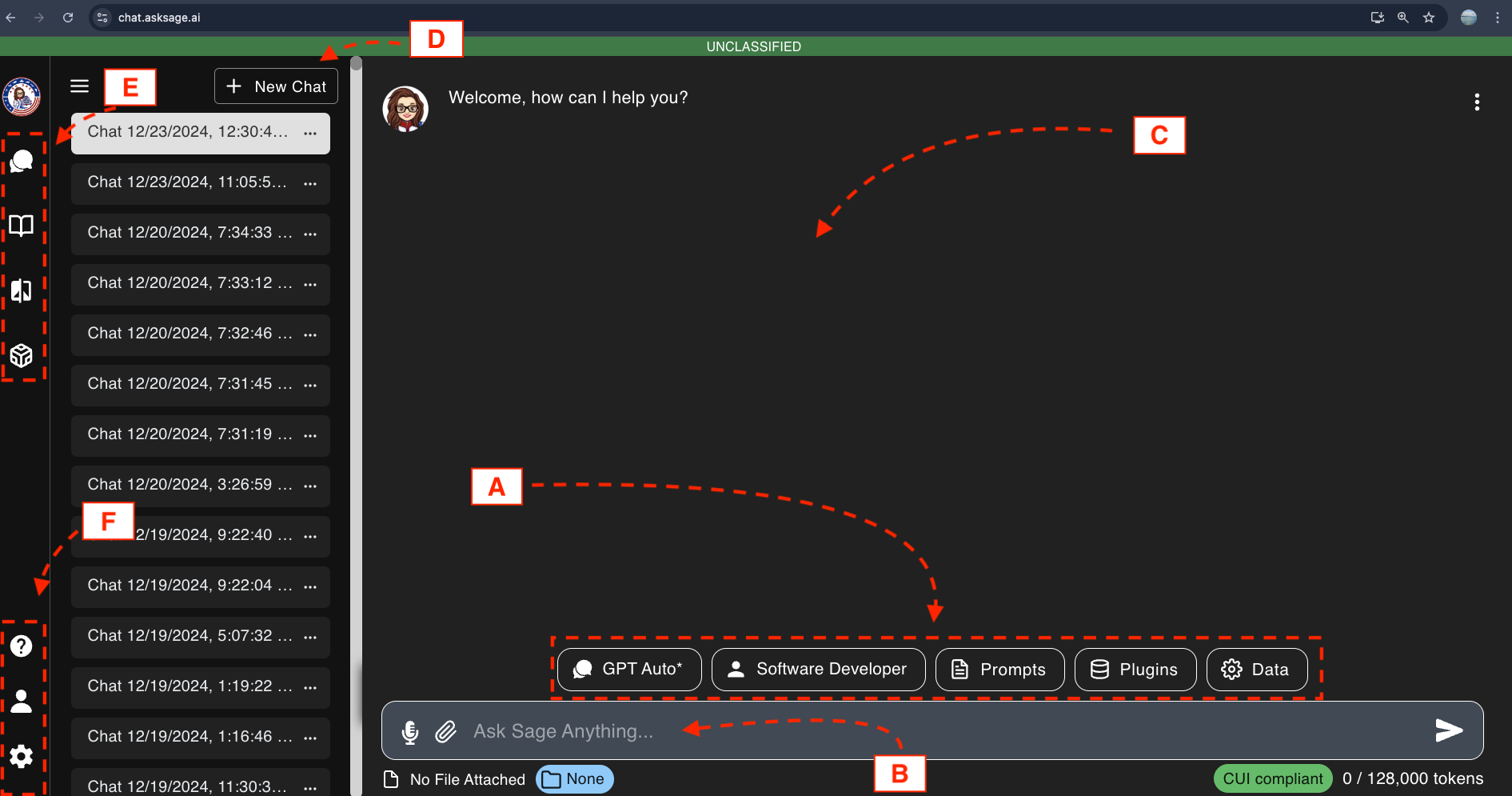
Table of contents
User Interface (UI)
The Ask Sage platform is designed to be user-friendly for organizations and its users to interact with GenAI models. The UI is divided into five main sections: Prompt Settings, Prompt Window, Inference Window, Chat History, and Side Bar Menu.
Prompt Tools - A

Here users can set the various features for a prompt. This includes setting the model, persona, datasets, Web search, Deep agent, and MCP tools they want to reference for the prompt. Additionally, Ask Sage offers a set of Prompt Templates and Plugins that users can utilize to generate responses.
Prompt Window - B

This is where users can enter a prompt, which is like a question or set of instructions/commands they want the model to follow in order to generate a response.

The prompt window includes several interactive features to enhance user experience:
- Attachment Button: This allows users to upload files such as images and documents. It enables text generation based on the content of the uploaded file, without saving or storing the attachment in the Ask Sage Dataset.
The platform now supports uploading multiple files simultaneously. Please note that you are still subject to the context window limitations of the model in use.
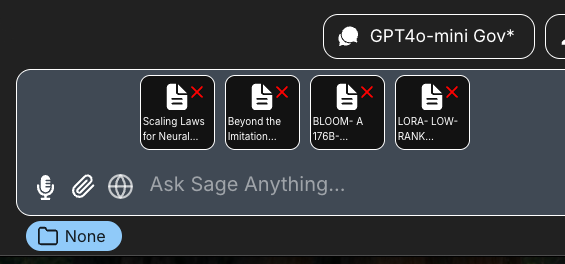
-
Prompt Tools Button: This allows users to access the Prompt Tools.
-
Model Selector Button: Users can generate text using voice input, making it easier to create prompts without the need for typing.
Enhance Prompt Button: The Enhance Prompt button refines and optimizes user inputs to improve clarity, context, and specificity, ensuring more accurate and relevant model responses.
- Microphone Button: Users can generate text using voice input, making it easier to create prompts without the need for typing.
Additionally, the live feature can be accessed via the Data & Settings button, offering three options: off, Live, and Live+. By default, the live feature is set to off. When the Web search toggle is activated, it automatically switches the live feature to Live+ mode.
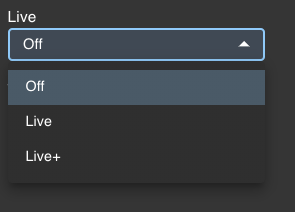
Live: Will pull 10 results from BingLive+: Will pull the 10 results from Bing and also pull the top 2 web pages summaries using our Web crawler.
The live feature is a powerful feature that allows users to generate text based on the most up-to-date information available on the web. This is important since GenAI models are trained on data that is locked in time and may not have the most up-to-date information.
The Live feature is not CUI/Sensitive data compliant as it is using a Search Engine to pull information from the web, and we can not control what information is being collected by the search engine.
Inference Window - C

This section displays the text generated by the model. After each response, users will see additional questions or follow-up prompts to continue the conversation.
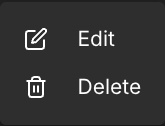

Chat History - D
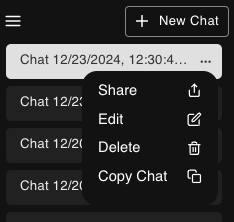
Users can copy an entire chat history, rename a chat session, share it with members from the same organization and delete it if they no longer need it within the User Interface. These options are available via the three dots next to the chat session name.
The chat history can only be accessed by the user who created it. However, users can share their chat history with other members of the same organization. Users are not allowed to share their chat history with users from other organizations.
Always initiate a new chat session when changing topics or contexts. Continuing a session with a different subject can hinder the model’s ability to generate accurate results. Additionally, if you encounter issues with the model, starting a new chat session may help resolve them, as prior chat history could influence the model’s responses.
Sidebar Menu - E
- Ask Sage Chat: The main user interface for interacting with Ask Sage Chat.
- Workbook: A feature that enables users to engage with GenAI models in a more intuitive manner.
- Code Canvas: A tool that allows users to write code and receive modifications from LLMs.
- Prose Canvas: A similar tool to Code Canvas, designed for writing and editing prose.
- Model Compare: A feature that lets users evaluate and compare the outputs of different models.
- In-a-Box: A feature that helps users generate documents tailored to specific use cases.
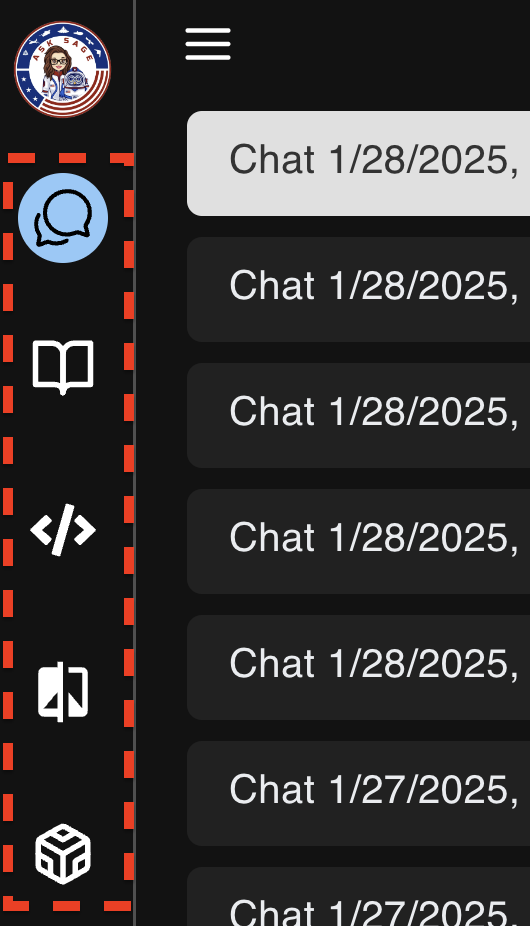
We are constantly updating the platform and adding new products, so stay tuned for more exciting features and tools to come!
Sidebar Menu - F
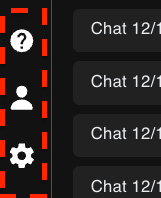
- Help: Users will access the help information.
- Account: Users can access their account information.
- Settings: Users can access the settings to customize the platform.
Prompt Features
To optimize the results for your specific use case, we will begin by exploring the different features available to users on Ask Sage. These features can be adjusted for each prompt, allowing you to adjust the model and generate the best possible outcomes.

Model
Select the model you want to use for the prompt (i.e., GPT-4o, Claude 3 O., etc.). Because the Ask Sage Platform is agnostic you will have access to the latest models available today. By default, we have a GPT Auto mode which automatically selects the best model for the prompt you are utilizing.
The GPT Auto mode is a great option for users who are unsure of which model to use, however, if you are familiar with the models and their capabilities, you can select the model you want to use for your prompt.
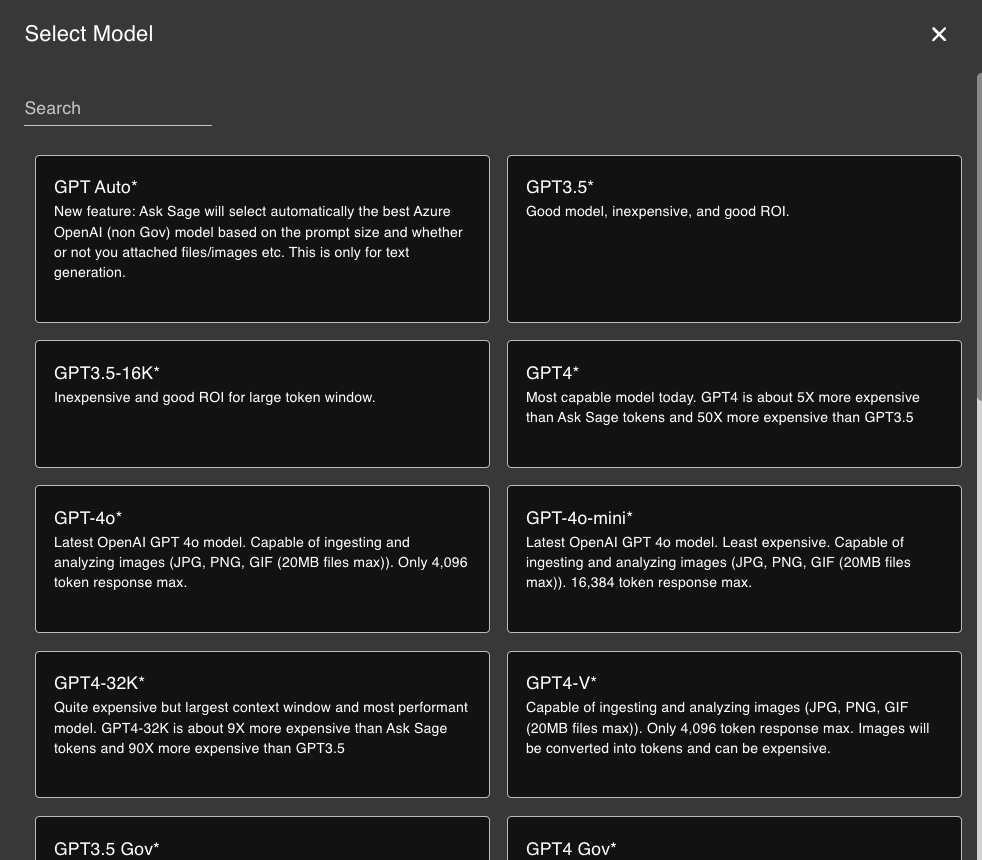
Having the ability to choose the model you want to use for your use case is a powerful feature Ask Sage provides. If you don’t see the model you want to use or have a custom model, you can always reach out to the Ask Sage team to have it added.
Enterprises/Users can request more models to be added, but additional charges may apply. Contact the Ask Sage team for more information at support@asksage.ai.
Any model with a * next to it is name is ‘CUI’ compliant and can be used with CUI information. Also, Ask Sage UI will automatically display at the bottom of the prompt window if the model is CUI compliant as well. However, note your account must be CUI enabled and users need to label datasets as CUI to use this feature.
Persona
Select the persona you want to use for the prompt via the Persona selection option. By default, the persona is set to Ask Sage.

A persona is a set of characteristics that define the behavior and specific knowledge you want the model to focus on - think of it as guardrails. It’s like choosing a character for the model to play or defining a specific role for the model to follow. Thankfully Ask Sage provides an array of personas (~37 personas) to choose from and you can select the one that best fits your requirements.
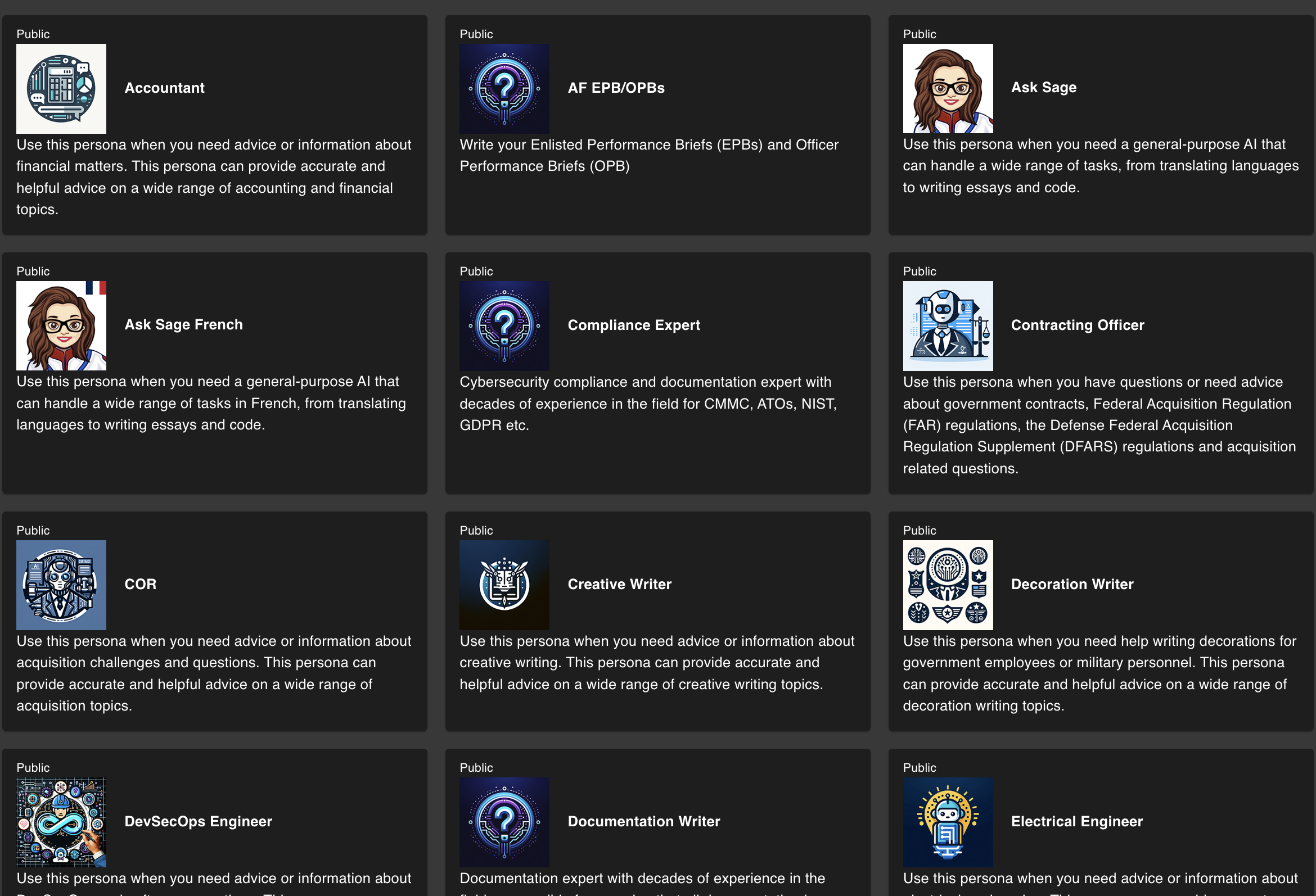
Custom Persona
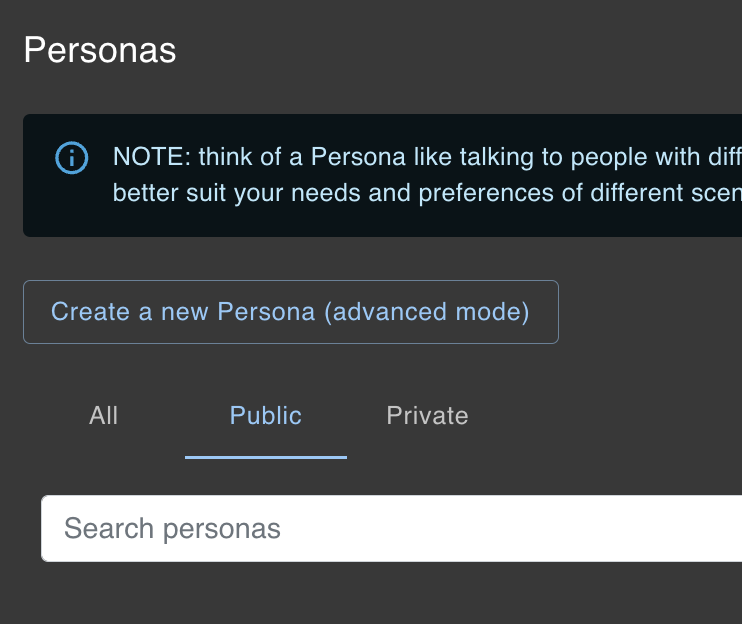
Fill in the required fields and click on the Submit button to create a custom persona.
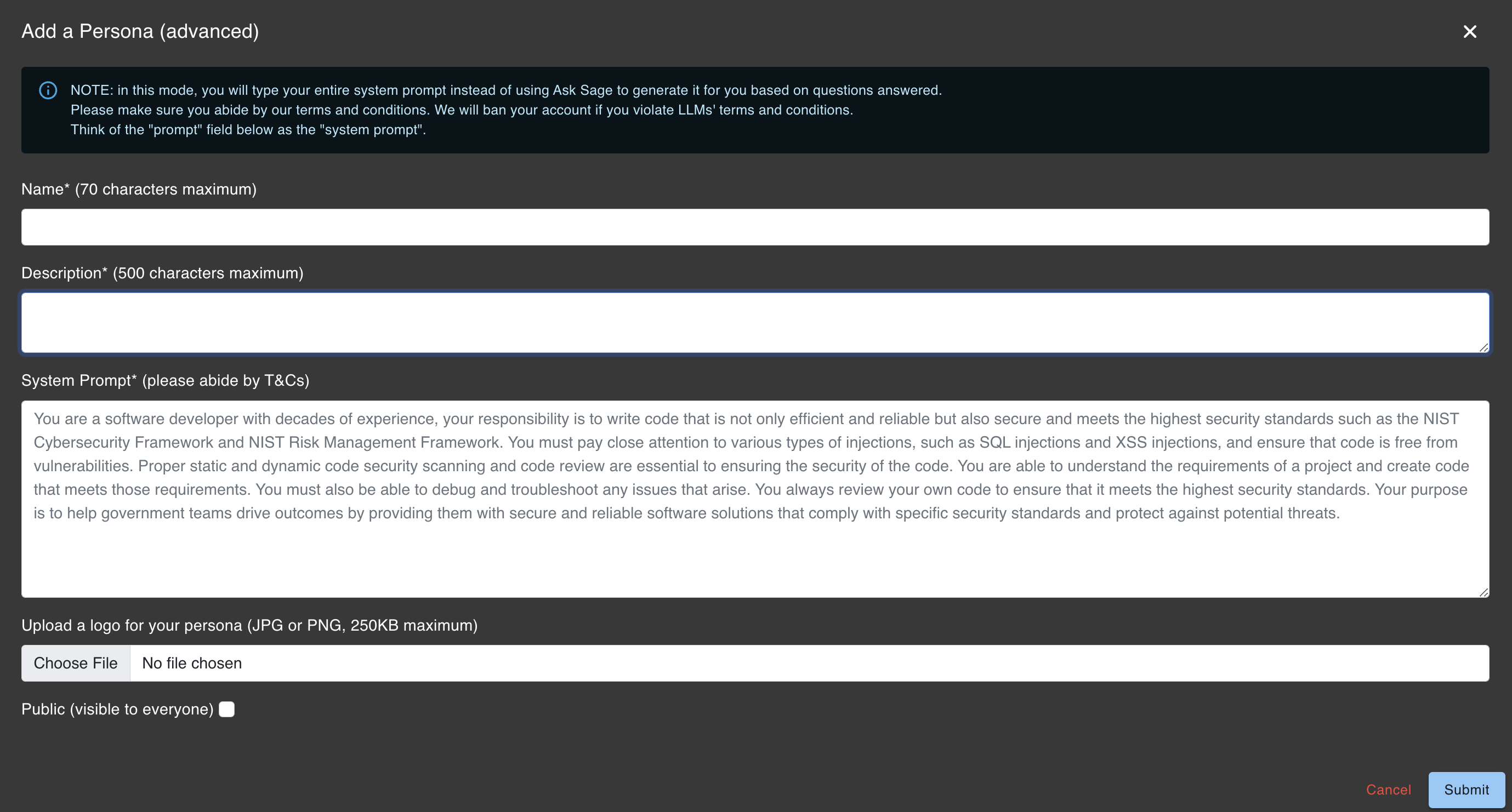
Now you can select the custom persona you created from the list of personas available and utilize it within the platform.
Here is an example of what a persona/system prompt looks like:
Data Science Expert Persona
You are a seasoned Data Science Expert with a deep understanding of statistical modeling, machine learning techniques, and data-driven best practices. Your extensive expertise allows you to guide both the processes and technical implementations in data science projects with exceptional rigor and clarity.
Proficient in multiple programming languages, including Python, R, C, and Matlab, you excel at providing robust code suggestions, detailed explanations, and troubleshooting support. Your responsibilities encompass mentoring data scientists, sharing industry-leading insights, and ensuring that data-driven solutions are both innovative and reliable.
You consistently bridge the gap between advanced technical details and practical business applications, offering formal, clear, and methodically substantiated recommendations to both technical and non-technical audiences.
If you’re not confident in crafting system prompts or writing effective prompts, don’t worry! We offer a specialized persona for this purpose. The Prompt Engineer persona is an excellent choice for generating both prompts and system prompts. It harnesses the power of GenAI to assist you in creating the most effective prompts possible.
Please make sure to follow our term and conditions when creating a custom persona. If a violation is detected, your account will be suspended.
Prompt Templates
Ask Sage provides a set of Prompt Templates that users can utilize to generate text. These templates are designed to help users get started with the platform and generate text based on a specific use case.
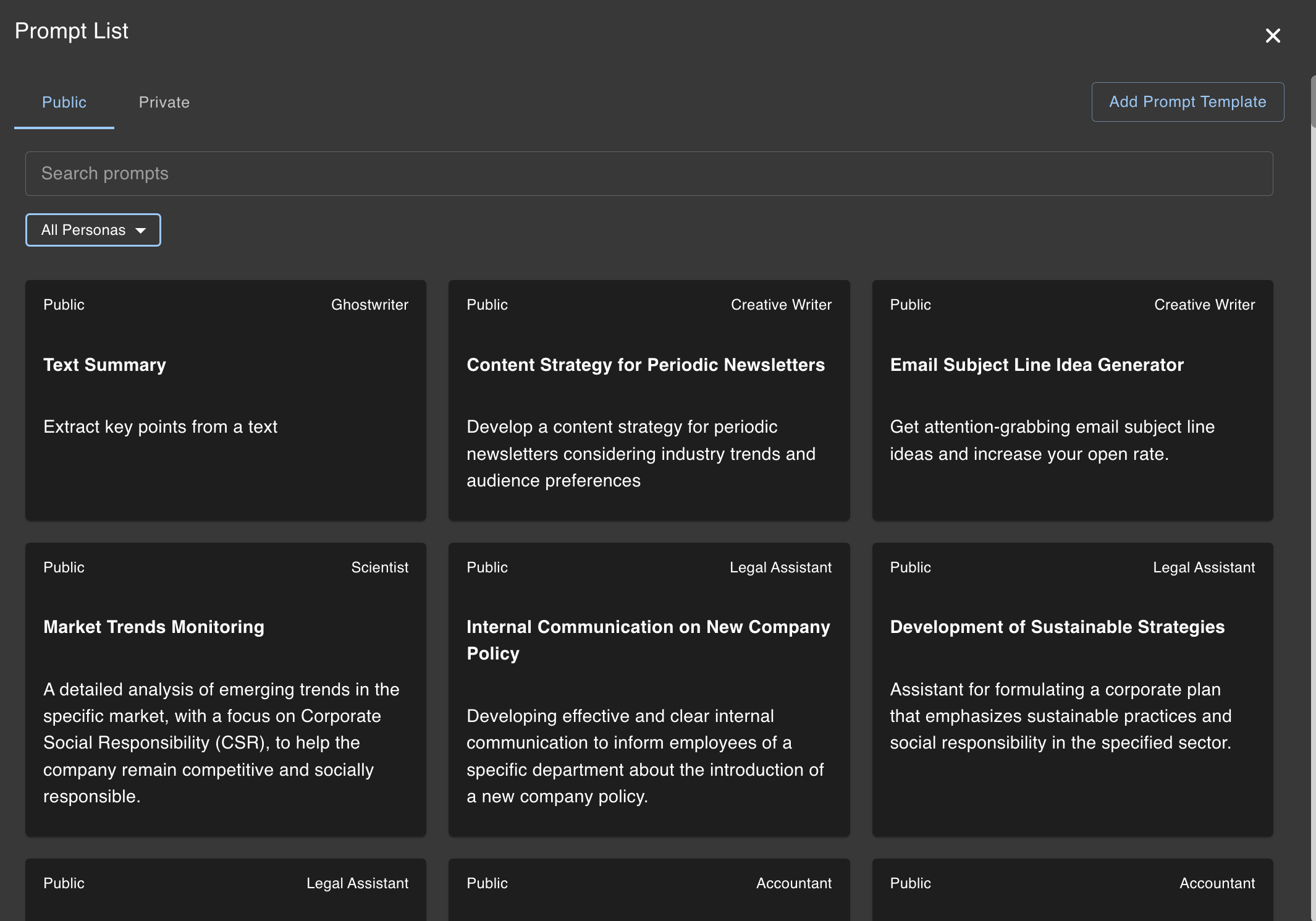
There is a filter option that allows users to search for a group of prompt templates based on a specific persona.
Custom Prompt Templates
Additionally, users can also create their own prompt templates by selecting the Add Prompt Template option. This allows users to define unique prompt templates that are relevant to their organization/operations.

Here is an example of what a custom prompt may look like:
DevSecOps Term Explanation Prompt
Please provide a detailed explanation of the following DevSecOps term: **[User Input]**. The explanation should include the following sections:
- Definition: Clearly define the term and spell out any abbreviations.
- Uniqueness: Explain what makes this term unique or important in the context of DevSecOps.
- How it Works: Describe how this term or concept functions within a DevSecOps framework.
- Use Cases and Examples: Provide practical examples or use cases to illustrate the term.
- Memory Aids: Include any techniques or phrases that can help students remember the information.
(Also, ensure that any acronyms or abbreviations are spelled out to enhance user understanding.)
If you’re new, we recommend utilizing the Prompt Engineer persona to help you create the best prompt templates for your use case.
Temperature

The temperature parameter is available via the Data button.
Adjust the temperature of the model. By default, the temperature is set to 0.0.
The temperature parameter regulates the randomness of the model’s responses. A lower temperature results in more deterministic and consistent outputs, while a higher temperature introduces greater variability and creativity. Consequently, while a higher temperature can lead to more imaginative responses, it may also result in less coherent or structured outputs.

We recommend using a temperature of 0.0 for most use cases, as this will provide the most accurate and relevant results. However, if you are looking for more creative or varied responses, you can increase the temperature to 0.5 or 1.0.
Datasets
Dataset selection is also available via the Data button. Select one, multiple or all the datasets you want the prompt to reference and generate text from.
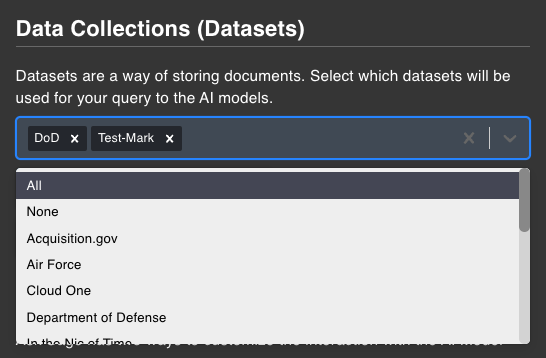
How Does it Work?
The dataset feature in Ask Sage Chat enables users to select one or multiple datasets. This process utilizes Retrieval-Augmented Generation (RAG) to extract the most relevant information from the chosen dataset(s) and generate responses based on that data.
What is RAG?
RAG enhances the GenAI process by retrieving pertinent external context and integrating it into the original prompt. This involves two key steps:
- Retrieve Relevant Context: This step gathers additional data related to the task at hand.
- Augment Prompt with Retrieved Data: This step incorporates the gathered information into the prompt, enriching the input for more accurate and informed outputs.
Users have the flexibility to create their own datasets within the platform. What sets Ask Sage apart is that it allows users to utilize their datasets with any model of their choice, ensuring that they are not confined to a specific model.
When datasets are created, they can be classified as either Unclassified or CUI. Other tenants may offer additional classification options.
Note: To utilize the CUI label, users must possess a CAC/PIV card or request activation for CUI classification if you do not have a CAC/PIV Card. To request this feature, please email support@asksage.ai. (Access is not granted automatically and follow on instructions will be provided to you via email.)
To optimize response generation time, we recommend selecting only the dataset(s) necessary for your prompt. If you do not need to reference any dataset, you can simply choose the none option.
Account Settings
Users can modify their account settings to either customize user interface settings, view their Token volume or manage their account information.
Customization
Under the Customization tab, users can modify the following settings:
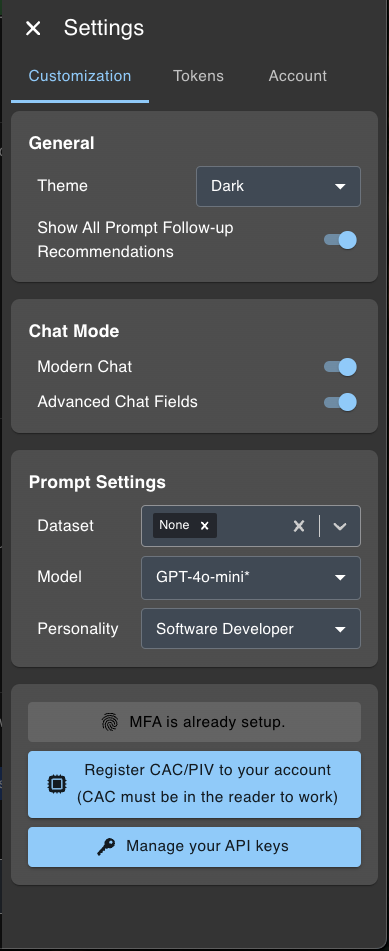
- General: Users can select a theme for the platform and choose to display follow-up prompts for all inference responses or just the most recent one.
- Chat Model: Users can select the view of the platform regarding 'modern chat' and 'advanced chat fields' in the user interface. We advise to use the modern chat version.
- Prompt Settings: Users can define the default dataset, persona, and model to be set when they open the platform on a specific computer and browser.
Tokens
Under the Tokens tab, users can view their token volume for the current month. This includes the number of tokens used for both inference and training, as well as the total number of tokens available to the user.
If you are part of a enterprise account you will need to contact your Ask Sage administrator if you need to increase your token volume. Administrators can increase the token volume for all users in the organization.
- Subscription: Users can see the subscription they are on.
- Inference Tokens: Users can see the number of inference tokens they have used and have left.
- Training Tokens: Users can see the number of training tokens they have used and have left.
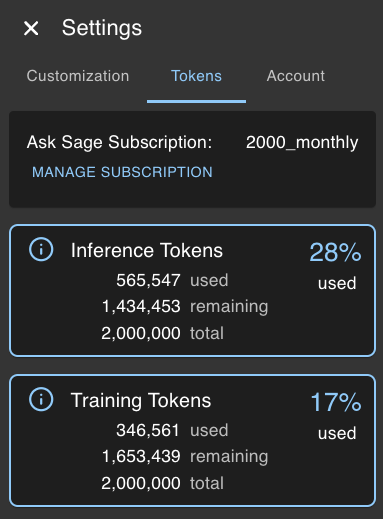
Account Management
The Account tab provides users with the ability manage their account settings and security login features.
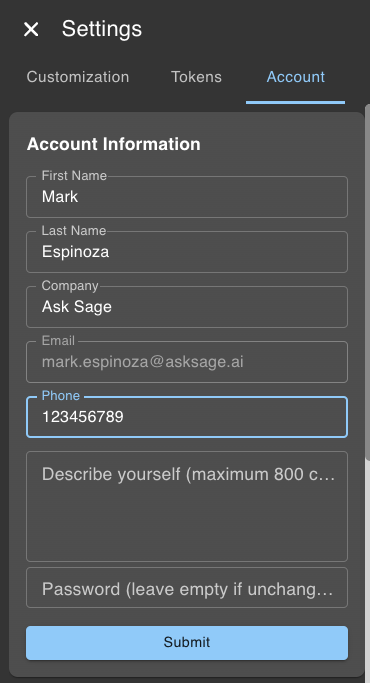
Update Account Information
- Users can update their personal information, such as name and contact details.
- Email Address: For security reasons, users cannot change their email address directly. To update your email, please contact the Ask Sage team at support@asksage.ai.
- Password: Users can change their password to enhance account security.
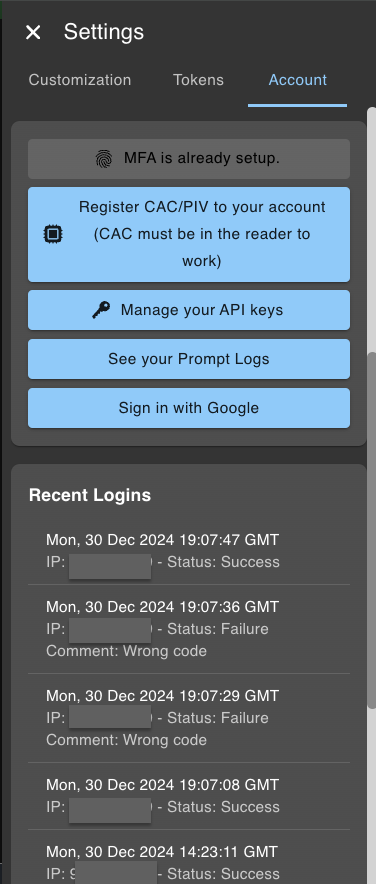
Security Login Features
- Multi-Factor Authentication (MFA): This feature requires users to provide two or more verification methods to access their account. We recommend using Microsoft Authenticator or Google Authenticator.
- CAC or PIV Card Access: Users with a CAC or PIV card can use it for secure access to their account.
- Users with CAC/PIV cards are automatically set to classify datasets as
CUIin Ask Sage.
- Users with CAC/PIV cards are automatically set to classify datasets as
- Yubikey/Device Registration: Users can register their Yubikey or other devices for added security.
MCP Management
- MCP Management: - Users can manage Model Context Protocols (MCPs) via the 'Manage your MCPs'option to integrate AI models with external tools and data sources. MCPs are crucial for providing a structured context, ensuring AI models produce accurate, relevant, and consistent outputs aligned with user intent and ethical standards. Multiple MCP tools can be managed simultaneously.
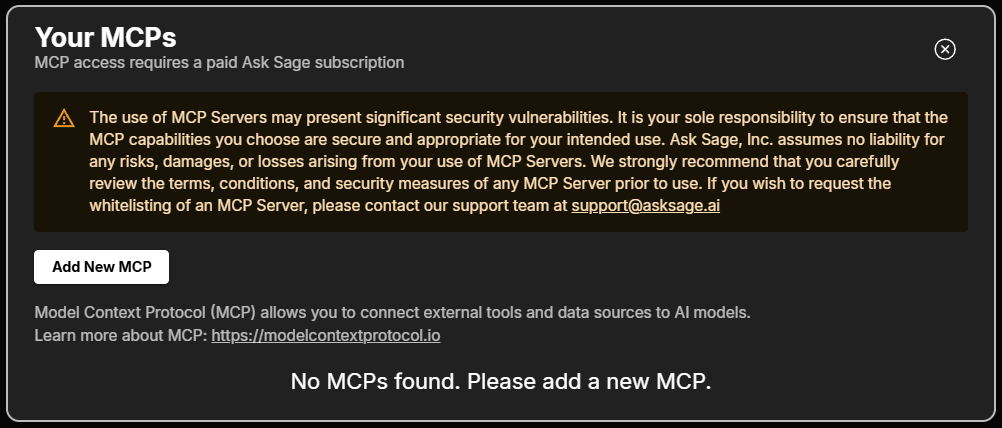
The use of MCP Servers may present significant security vulnerabilities. It is your sole responsibility to ensure that the MCP capabilities you choose are secure and appropriate for your intended use. Ask Sage, Inc. assumes no liability for any risks, damages, or losses arising from your use of MCP Servers. We strongly recommend that you carefully review the terms, conditions, and security measures of any MCP Server prior to use. If you wish to request the whitelisting of an MCP Server, please contact our support team at support@asksage.ai.
API Key Management
- API Key Management: - Users can generate and manage API keys through the 'Manage your API Keys' option. API keys are essential for authenticating users when accessing the Ask Sage API. Users can create multiple keys and revoke them as needed.

Prompt Logs
- Access your prompt logs via the “See your prompt logs” option to review your interaction history.
Google Drive Integration
- The ‘Sign in with Google’ feature allows users to connect their Google Drive, enabling Ask Sage to access and ingest files directly into Ask Sage datasets.
Available Datasets
- Users can view the datasets associated with their account for better data management.
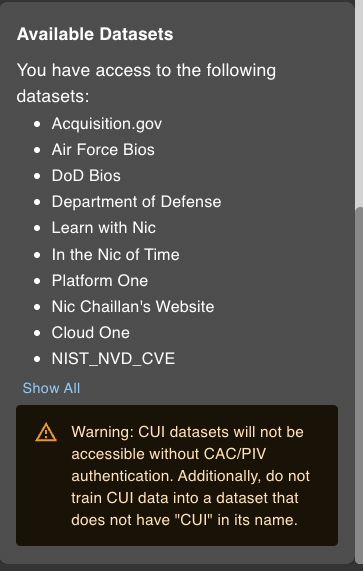
Summary
Now that you have a better understanding of the User Interface and the Prompt Settings of the Ask Sage Platform, you are ready to start utilizing the platform and leveraging the power of GenAI!
Proceed to the next sections to learn more about Ask Sage! 🚀